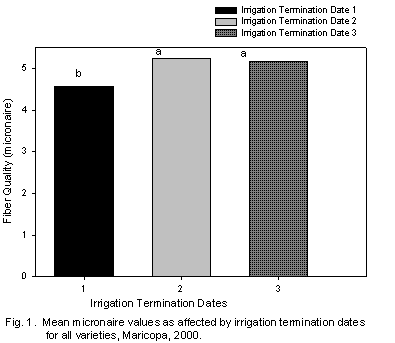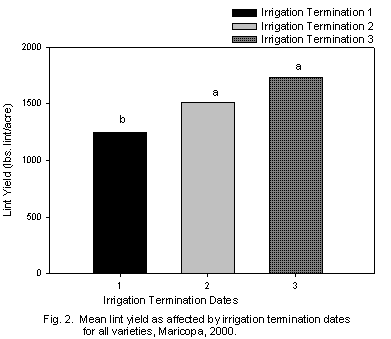Late Season Management and Possible Impacts on Yield and Micronaire
by Jeffrey C. Silvertooth,
Extension Agronomist, Professor & Head, SWES
At this stage in the season the Arizona cotton crop is developing rather well in most areas. Obviously, we still have many weeks of the season left and a number of management challenges ahead of us (insect damage, heat stress and fruit abortion, etc.). So, despite the poor market conditions, the Arizona crop still carries a good potential, at least in terms of yield at this time.
In recent years, high micronaire (mic) values have been an increasingly important issue to the Arizona cotton industry with a significant portion of the fiber experiencing discounts on the market value. In the 2000 crop season, we initiated a group of experiments to evaluate a number of factors affecting fiber mic. A factor that appeared to significantly influence final fiber mic was late season management and crop termination (see Cotton Comments, 6 May 2000, Management Factors Associated with Fiber Micronaire).
An experiment was conducted at the University of Arizona Maricopa Agricultural Center (MAC) in 2000 to specifically evaluate lint yield and fiber mic results in relation to irrigation termination (IT) management. A group of 13 upland varieties was dry planted and watered-up on 6 April 2000 and grown uniformly until the crop began to approach the later stages of the primary fruiting cycle, at which time three IT treatments were imposed (Table 1). The first IT treatment provided the last irrigation on 25 July when the crop was just slightly ahead of cut-out (NAWF ~6). This IT treatment intentionally terminated the crop early in an attempt to reduce overall fiber mic and evaluate the impact on final yield in comparison to later IT treatments. The second IT (17 August) included two additional irrigations over IT1 (12 acre-inches additional water), which provided one irrigation beyond what would have been optimal for complete development of all bolls set up to cut-out (NAWF < 5). The final irrigation for the third treatment (IT3) was applied on 15 September to accommodate the development of a top-crop (24 acre-inches of water more than for IT1). Following the final irrigation, treatments were defoliated and harvested in an expedient manner. One of the many measurements conducted in this study included the collection of a set of bolls from the lowest four, first position bolls (Low 4) as soon as boll opening began to occur. In addition, a set of 25 open bolls was randomly collected just prior to harvest throughout the canopy and a sample from the top four first position bolls (Top 4). More detailed descriptions of this and related projects and results are published in the 2001 University of Arizona Cotton Report, Series P-125. The 2001 Cotton Report can also be found on the Arizona Crop Information Site (ACIS) website at http://cals.arizona.edu/crops/research/reports.html.
Results are outlined in terms of overall (averaged among all varieties) fiber mic and yield in Figures 1 and 2 for each of the three IT treatments from MAC in 2000. In this experiment, we were able to reduce fiber mic for 12 of the 13 varieties below the discount level (mic > 5.0) for the first IT treatment. For the second IT all varieties had mic values greater than 5.0 and for the third IT all but one variety had mic > 5.0. Lint yields also increased significantly with later IT treatments in this study. From these results it is clear that we realized a very strong top-crop for most varieties. This enhanced yields significantly but did not improve mic values in this case. We also found that the Low 4 samples provided a good estimate of final mic potential and that final mic could be reduced due to IT treatment.
It is important to point out these results are from one experiment (one site/one season) and we are continuing with two sites in 2001. However, it appears that late season management and crop termination can have an impact on fiber mic. It is therefore important to consider the potential impact of crop IT on final mic, yield, and crop value from this stage of the season forward. Hence, carefully evaluating crop condition and boll load as the crop develops from peak bloom to cut-out can be very important as late season management decisions are made.
|
Varieties |
Maturity Type |
|
BXN47 |
Medium |
|
DP428B |
Short-medium |
|
DP422BR |
Short |
|
DP33B |
Full |
|
DP20B |
Early |
|
DP388 |
Medium |
|
STV474 |
Medium |
|
STV4691B |
Medium |
|
SG125BR |
Short |
|
SG747 |
Medium |
|
DP655BR |
Full |
|
DP451BR |
Medium |
|
DP5415 |
Full |
|
Irrigation Termination (IT) Dates |
HUAP and Additional Water Over IT1 |
|
Date 1 (25 July) |
2561 HUAP 0 |
|
Date 2 (17 August) |
3201 HUAP 12 acre-inches |
|
Date 3 (15 September) |
3970 HUAP 24 acre-inches |
Issued in furtherance of Cooperative Extension work, acts of May 8 and June 30, 1914, in cooperation with the U.S. Department of Agriculture, James A. Christenson, Director Cooperative Extension, College of Agriculture and Life Sciences, The University of Arizona.
The University of Arizona is an equal opportunity, affirmative action institution. The University does not discriminate on the basis of race, color, religion, sex, national origin, age, disability, veteran status, or sexual orientation in its programs and activities.
Any products, services, or organizations that are
mentioned, shown, or indirectly implied in this web document do not imply
endorsement by The University of Arizona.
Information provided by Jeffrey C. Silvertooth, silver@ag.arizona.edu
Extension Agronomist, Professor & Head, SWES, College of Agriculture and Life Sciences, The University of Arizona.
Material written July 16, 2001.
Crop Mgmt | Soil Mgmt | Irrigation | Varieties | Cotton Comments
Home | Cotton | Advisories
document located at: http://cals.arizona.edu/crops/cotton/comments/july2001cc.html
Copyright © 2001 University of Arizona,
College of Agriculture and Life Sciences
Webmaster: Al Fournier (acis@ag.arizona.edu)

